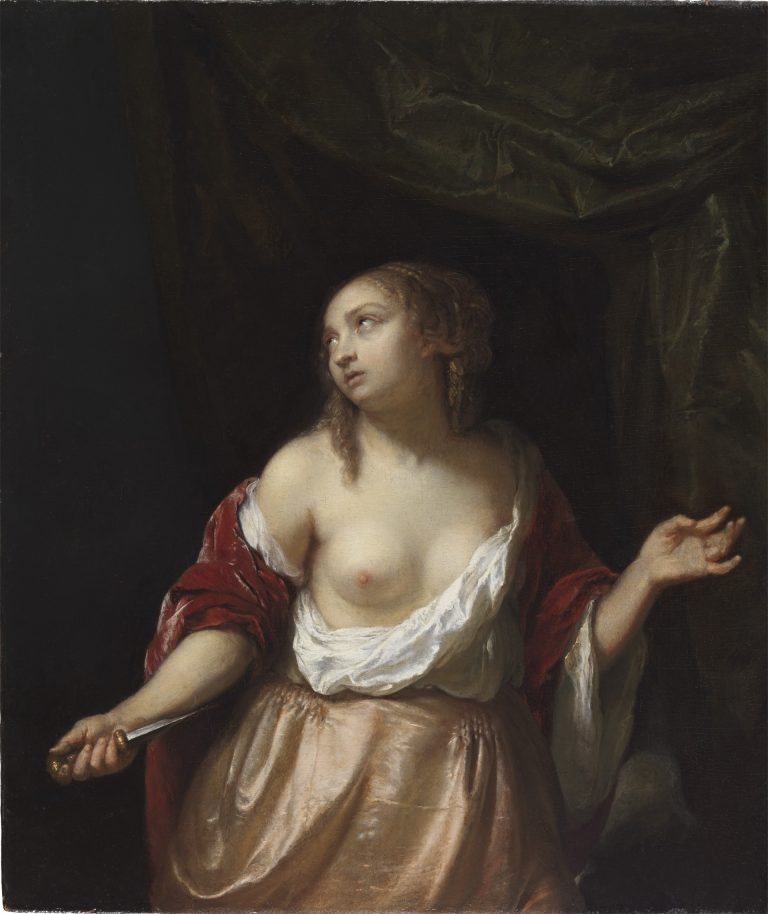The story of the Roman heroine Lucretia is recounted by Livy.1 The beautiful wife of Lucius Tarquinius Collatinus, a Roman nobleman of the sixth century B.C., Lucretia was renowned for her virtue and loyalty. She was raped by Sextus Tarquinius, son of Lucius Tarquinius Superbus, the tyrannical Etruscan king of Rome. Lucretia revealed the defilement before her father, husband, and other male relatives and then—to preserve her honor and the good name of her family—committed suicide by stabbing herself in the breast. To avenge the rape, one of Lucretia’s kinsman, Lucius Junius Brutus, led a revolt to overthrow the monarchy. Brutus and Lucretia’s bereaved husband, Collatinus, subsequently became the first consuls of the Roman Republic.
Lucretia’s tragic and emotionally complex story came to exemplify an equally complex array of abstract concepts: patriotism and the victory of liberty over tyranny; love and faithfulness unto death; and virtuous female chastity most of all. Historical reaction to the Roman heroine was not consistently positive, however, and early Christian writers tended to condemn her for choosing the mortal sin of suicide over the lesser evil of adultery. Nonetheless, the story of a woman who chose death over dishonor was steadily popular in a culture that placed such great emphasis on female chastity.2 Representations of Lucretia’s suicide abounded in early sixteenth-century paintings and prints, especially among Northern European artists: Albrecht Dürer, Lucas Cranach, Hans Baldung, Jan van Scorel, Joos van Cleve, Jan Gossaert, and Pieter Coecke van Aelst were among the many that depicted the theme. The majority of these images removed Lucretia from a narrative context and isolated her figure against a neutral background, thus promoting a greater sense of intimacy between the figure and the viewer (fig 1). Although Livy and other classical authors described Lucretia as “modestly clothed,” most of these images show her either partially clad or completely nude, perhaps prompted by the recent discovery in Rome of an antique statue of a nude woman believed to represent Lucretia.3
The isolation of the figure and the exclusion of narrative context in these images have been linked to the conventions of Christian devotional imagery, which employed similar formal strategies to focus the viewer’s meditations on the sufferings of Christ or the particular saint depicted, and thus encourage empathetic response.4 Adopting these conventions was only logical, as Lucretia herself was often regarded as a sort of secular martyr. Unquestionably, however, the voyeuristic appeal of intimate engagement with a (semi)nude woman—no matter how noble or virtuous—and the illicit eroticism of Lucretia’s rape were the key factors in the continued popularity of the theme.
It is not surprising that Caspar Netscher chose the story of Lucretia for what was probably his first attempt at a historical subject. Although Gary Schwartz and others have convincingly proposed that Rembrandt’s intensely charged Lucretia paintings of 1664 and 1666 might have been inspired by contemporary political events and the concomitant parallels drawn between the foundation of the Roman and Dutch Republics,5 it is not at all clear that Netscher intended his painting, made during this same period, to embody similar associations. Like many genre painters who also turned their hand to painting small-scale history pieces during the 1660s and 1670s (FM-103), he chose a well-known subject that lent itself to a genre-like approach in terms of clothing, setting and accessories, and that afforded an opportunity to depict a voluptuous semi-clad figure under a cloak of historical respectability.6 Here, posed before a curtained bed in a darkened interior, Lucretia bares her breast to receive the dagger’s thrust, her tear-filled eyes rolled heavenwards. In general terms, Netscher’s decision to isolate the figure before a barely visible background recalls the sensuous Lucretias created by sixteenth-century Northern artists, but the sharp turn of the figure’s head and her pathetic upward gaze seem to have been more directly inspired by Guido Reni’s numerous depictions of Lucretia and the equally tragic Cleopatra (fig 2).7 In both instances, the artist has deliberately eliminated any possibility of eye contact between figure and viewer, allowing the viewer to intrude freely upon an intensely private scene. In analyzing the voyeuristic appeal of Reni’s paintings specifically, Richard Spear has noted that the eroticism of his Lucretias “derives less from nakedness than from their vulnerability and the violation done to them: from the pending plunge of a cold, sharp dagger into pale unblemished flesh.”8 The same might be said of Netscher’s Lucretia as well.
Lucretia, which is in good condition, was probably painted about 1665–67.9 The same model appears in Netscher’s genre paintings of the mid-1660s (fig 3), many of which project a similar sensual and sensorial appeal. In these works, Netscher often combined discreet glimpses into private domestic worlds with a detailed attention to the tactile surfaces of fabric and flesh (see also CN-108). Were it not for Lucretia’s artfully disheveled garments and the slim dagger clutched in her outstretched hand, she could easily be mistaken for one of these pampered seventeenth-century beauties. By limiting accessories to a generous swag of green drapery and a pillow hinting at the presence of a bed in the right background, Netscher avoids tying his representation to a specific time and place. Some have faulted Netscher’s history paintings for lacking a certain dignified historicism; the nineteenth-century critic Charles Blanc, for example, remarked, “the notion of the antique, the sublime conventions which form the ideal in art, were too elevated for his spirit. . . . [He] did not forego [using] some pretty Hague lady as the model for his Cleopatra, or Cleopatra herself as the pretext for a beautiful satin robe.”10 Nevertheless, the very contemporaneity of Netscher’s Lucretia is what contributes most significantly to her sensual appeal.
